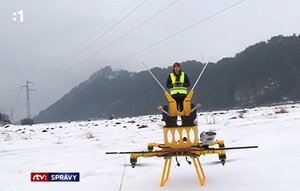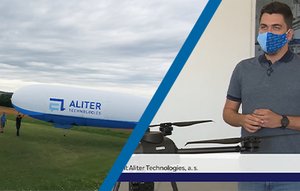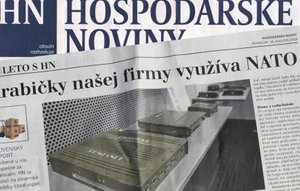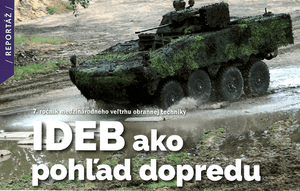These are the Slovak UAVs deployed to protect the Pope as well as manage security at the Rammstein concert. They instantly captured the world’s attention:
Aliter Technologies is a Slovak-based tech company whose product portfolio, features drones (UAVs) not only used by institutions at home but also popular across international markets. In their home country, Slovakia, their UAVs even protected Pope Francis and supervised security during a huge open-air gig of the German band Rammstein.
Born and raised in Bratislava, Ákos Haramia has been working with drones since college. He was still an undergraduate when he and his classmates founded a small startup. Fueled by their fascination with UAV advancements, they self-funded their initial forays into the field.
Years later, already under the wings of Aliter Technologies, Ákos participated in the development of the VIMA drone (VIMA as in Virtual Mast), which operates as a universal flying platform for various types of hardware applications. In addition to carrying a camera with day or night vision, the UAV is capable of complementing a missing or insufficient communication network within a few minutes.
What are the strengths of VIMA, the Slovak virtual mast, and where exactly can it be used?
Your drones are a global success. How exactly are they manufactured in Slovakia?
The production itself takes place in Bratislava and its surroundings. Some details, such as the surgical precision assembly of printed circuit boards, are supplied by an external contractor specialized in the segment.
Every drone’s journey starts with a mission in mind. Our engineers meticulously design each one to achieve these specific goals. Once a prototype is built, it undergoes a rigorous testing phase that can last a year or more. We need to make sure our drones will work in all kinds of weather conditions and temperatures.
Specifically, our VIMA virtual mast must also comply with the MIL-STD requirements – or at least the temperature range required by these standards. The drone has to endure sunshine for an entire day, when the temperature inside the device may rise to 80 °C. Conversely, we’ve also tested it in freezing environments, placing it in cooling chambers with temperatures as low as -20 °C.
You call it a virtual mast, but it is, in fact, a drone. So, how exactly does VIMA work?
It’s not a conventional drone to fly with. Our aim with this drone was literally to substitute a static mast, hence the name “Virtual Mast”. We wanted to ensure that a police officer, paramedic, soldier, event manager, or anyone else for that matter could easily and quickly set the device up anywhere and let it do its job autonomously with no need for control or monitoring. The device can be set up and take off within minutes.
VIMA is built entirely in-house, allowing for customization to meet specific client needs. The system consists of two core components: the aerial vehicle itself and a ground station housing all the electronics and a special cable that automatically manages take-off and retrieval.
This drone functions as a universal flying platform thanks to its interchangeable payload system. Mounted on top, a dedicated radio unit allows for the rapid deployment of communication networks. Meanwhile, the bottom section provides a flexible docking point for various specialized tools, such as cameras, speakers, LED lights, environmental sensors (including ambient temperature and air purity), or even drone detectors.
The drone can self-regulate its height autonomously according to weather conditions to prevent mechanical damage. Our goal was to minimize the need for manual control.
A drone that cannot fly freely is quite a rarity.
Pioneering the use of UAVs for bird diverter installation, we found ourselves with a highly skilled team eager for new challenges. We had a team of experts with nothing to do so we had to keep them busy one way or another (laughs).
At the time, the Aliter Technologies Special Systems Division consisting of people with a military background contributed most profoundly to the brainstorming process.
Some of them had previously been on missions in Afghanistan and Iraq, so they have real-world experience with what soldiers encounter on the battlefield and what they really need.
Our colleagues, former professional soldiers, went on to explain to us that one of the most common challenges of any mission – and this does not only concern the military deployments – was always the building of a communication network. So our UAV stands out for its second-to-none versatility.
In Slovakia, we saw the VIMA deployed, for example, at a Rammstein concert. Why did the organizers need it there?
Our concern was not primarily to monitor the space in front of the stage, because static cameras were doing that job well, instead, we focused mainly on the traffic – that is, parking of vehicles and their movement in general.
We were monitoring the access routes to the airport where the concert was held. The security team that was working on-site received traffic information from us. This helped them steer and divert traffic, as necessary.
We used different types of cameras, including cameras with a very powerful optical zoom.
How many drones did you deploy there? Did you help the organizers identify any specific threat?
We only had one UAV, operating at a height of 70 meters, and even that was enough to cover the entire concert venue and the parking lot at the same time. If the drone is high enough and has a camera with a reasonable zoom capability, it enables you to see far away and cover the entire area.
Luckily, nothing serious happened at the concert. An interesting moment occurred when we found out at night that some people broke through the barriers in places where access was prohibited.
If it weren’t for us, no one would have had a chance to find out, but we saw the incident and identified it using infrared cameras. The security team then sent their people in, who addressed the situation in no time.
When you participated in the Pope’s visit, you surveyed a crowd twice as large as the one at the Rammstein concert. Did you have to adapt your technology to a larger mass of people?
Essentially, it was the same thing – we arrived one day in advance and helped guide and steer the arrival of visitors. The biggest difference was that at the Rammstein event, we were connected to the control center by cable, while during the visit of the Pope, we were quite far away from each other, so the entire data was sent over the radio.
The Ethernet cable offers effective transmission only over a distance of about 100 meters, so we decided to use MANET radio – this is a military technology that enables the sending of encrypted data.
As for visitors, it was much more peaceful than we had expected. In particular, we helped with the management of entrance points to prevent unnecessary extreme queuing in some locations or times.
Did you witness any incidents there, too?
For example, there was another drone flying within the perimeter, which was not supposed to be in the area at all. We were able to spot it and immediately provided the data to the police, who took over to deal with the incident from that moment.
It can get dangerous when a public user flies drones during such events. These devices can fall at any time, and even a 250-gram drone may cause severe injuries.
Any drone used by law enforcement, or first responders may also have to face other threats than just gusting winds. What happens if it breaks off or is otherwise damaged?
In the event of a power outage or cable breakage, the drone has a built-in battery that allows it to land autonomously. However, for safety reasons, it also has its own parachute to minimize the risk of any damage to the equipment it is carrying.
It can be controlled via virtually any kind of tablet that enables the installation of our app. In fact, several VIMA drones can be controlled via one such tablet.
What exactly is so challenging about creating a communication channel? It doesn’t come across as too complicated in war movies.
Radio technology operating in gigahertz bands actually works by using a very simple principle – when two antennas can ‘see’ each other, both radio devices can communicate. However, the range of such a surface communication is only a few hundred meters, with a maximum distance of one to two kilometers.
VIMA is a great example of how we did not just invent the product first and then started to look for a market to sell it. It exemplifies our commitment to developing products driven by market needs, not simply invention alone. We prioritized understanding customer demand before bringing the product to life.
Under ideal conditions, our UAV can transmit signals to distances reaching as much as 50 km, which is several times the range of conventional radios. Of course, by definition, emergencies never happen in ideal conditions, and, in a challenging environment, we may need more than one drone.
Let’s look at the pragmatic side of the virtual mast from the point of view of a music festival organizer. Can it replace conventional cameras?
VIMA does not necessarily replace conventional cameras but complements them to increase the overall surveillance capabilities. The difference between a static camera and a drone is that the drone does not need any frame or construction to stand on and is by definition a mobile device.
Setting up our virtual mast makes sense if you need to monitor an event from a great height for a few days and coordinate static cameras and your people in the field.
An alternative would be to build a 50- to 100-meter mast with a 360-degree camera, however, such an endeavor already requires a permit from the authorities and a concrete foundation, which may be unrealistic for most organizers.
Conventional cameras do not provide the organizers with such a good overview and an immediate opportunity to identify problematic locations. This cannot be done. You may have cameras on the ground and a team of, say, 20 people, but you will never have a 360-degree overview as from the air.
Event organizers often barely fit into their expected budget. Doesn’t your solution represent an unnecessarily large expense for the organizer?
The entire set-up is adapted to the needs of the client and the venue, and the final price tag for this service is calculated on a ‘person-day’ basis depending on the technology used and the people needed to operate it.
Today, artificial intelligence can already recognize weapons and other objects in video recordings. Is VIMA able to autonomously detect specific threats?
This is actually a matter of calculation performed in the background, so all it has to do with the drone itself is the usage of the drone’s high-resolution camera.
At the time of the Pope’s visit, we were using technology that could recognize people, cars, and trucks. Recognition of faces, movements, or specific objects is only a matter of software.
UAVs are one of the fastest-growing technology segments. What do you think will be the next big thing in the industry?
I have always strongly believed that full autonomy is the key to unlocking UAVs’ true potential. As long as there is always someone there who has to control or supervise drones, it is still a mere working tool, just like, say, a mechanical drill for a worker.
In fact, the existing technology already makes it possible, but legislation still does not allow it.
What exactly does autonomy mean for UAVs?
Imagine, for example, a large refinery or another large industrial enterprise where inspections must be carried out on a regular basis.
The way it works today is that chimneys and other dangerous locations have to be physically climbed and inspected by humans. This is a lengthy, dangerous, and generally ineffective practice.
Drones may carry various sensors, such as a thermal camera, thermometer, or air quality sensors. This could practically be performed by a drone that would simply take off from its base and automatically do what it is programmed to do.
Then it would return to the base, upload the data, recharge the batteries, and resume operations. All the while it would perform the processes better and safer than a human.
The current perception of drones as video shooting assistants will be eclipsed by a future teeming with UAVs fulfilling a multitude of roles.
What is the stage of legislative development in Slovakia and when will it be possible to make full use of the potential that UAVs have to offer?
European legislation distinguishes the types of drones by weight and flight path – whether it’s flown over people, a residential area, a private property, or over some completely uninhabited territory.
Depending on how large the drone is and over what area it flies, the legislation determines what the user can do with it.
Just a few days ago, the Slovak government approved an amendment to the Aviation Act. As stated in the draft amendment to the act: The new legislation will ensure that the area of unmanned aircraft, unmanned aerial systems, and U-space will be regulated by a comprehensive national legislation, taking into account the areas previously regulated by relevant legally binding acts of the European Union and those areas that are not yet regulated by legally binding EU acts. This will not only implement the relevant legally binding EU legislation but also remove some existing obstacles in civil aviation. The law should enter into force on 1 July 2024.
SOURCE: Fontech
Mohlo by vás zaujať
Drones can protect birds.
Products from the Special Systems division were presented in 2 reports for RTVS.
Daily news Hospodarske noviny looked at our products that succeeded abroad.
Aliter Technologies was a part of the article about IDEB 2018 in the June issue of the month OBRANA. Furthermore, you can read in the article about...




